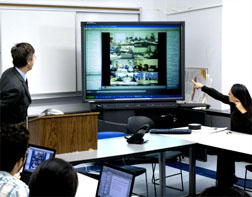One of the most popular uses of educational audiovisual content is in the form of lecture capture, which can be audio or video recordings of lecture presentations and presentation materials.
Get Started with Lecture Capture
To get started with lecture capture for your courses, we recommend contacting a CCNMTL educational technologist. Click here to find out which educational technologist serves your department at Columbia University.
CCNMTL offers consultation and services related to lecture capture for Columbia faculty who wish to provide students with recordings of lectures as a study aid. These recordings are not intended as a substitute for classroom attendance; in fact, research has proved that making recordings available does not reduce attendance (Copley 2007). Students treat the recordings as study materials akin to lecture notes (Instructional Technology Survey 2008).
We encourage faculty to approach lecture capture thoughtfully. The faculty member's lecture style and goals for the recorded lectures inform our approach, which can range from simple audio documentation of lectures to more "produced" representations that include attention to the visual elements. We offer a set of best practices for lecture capture that comprises both the technical and pedagogical characteristics of recording.
Technical Methods
When planning to record lectures, whether a single class or an entire semester, we first consider the content being delivered--whether it is primarily audio or a combination of audio and visual, involving slides, videos, or live demonstrations--and any interaction with students. We design our method of recording around these requirements and to enable self-sufficiency whenever possible. We also consider how quickly students need to receive the recordings, whether the recorded lectures are intended for the current semester only or might be used again in the future, and the optimal means of delivering the recordings to students, such as via CourseWorks or an iTunes U podcast.
Pedagogical Methods
The power of multimedia is well documented. On the level of efficiency, not only can students use recorded lectures to reinforce what they learn in lecture, they also can focus less on transcription and more on conceptual understanding. Making recorded lectures available before class meetings makes more time available for discussion and hands-on activities. In the classroom context, multimedia can be a powerful tool for helping students learn and retain complex ideas and phenomena. The more stimulating and engaging the lecture, the more advanced the method for capturing as audio or video.
Best Practices for Lecture and Course Capture
Based on observations of other institutions techniques in producing videos of lecture content, we have put together this list of best practices so that instructors that want to record their own lectures can producing optimal materials for student viewing:
![]() Example of Lecture & Course Capture
Example of Lecture & Course Capture
 | ||
The Global Classroom project organizes and delivers lectures and readings for a master's level, sustainable development course simultaneously taught at a dozen universities around the world. Conceived as a new distributed learning curriculum by a sub-committee of the Commission on Education for International Development Professionals, the course engages diverse bodies of students in a live discussion with a Commissioner lector about some of the world's foremost issues in sustainable development. Throughout each semester, local course facilitators and instructors draw on common syllabi and videotaped lectures, reading assignments, and other resources available through a "super site" course management system developed by CCNMTL. To enhance collaboration and information sharing, students listen to videotaped lectures outside of class, and use class time to engage with lectors in an online seminar. Students and instructors are also provided with a Web-based environment, including an online forum, to encourage cross-institutional discussion and collaborative assignments.
![]()
Articles and journals on lecture capture and educational podcasting
- Harvard University, Department of Romance Languages and Literature. Instructional Technology Survey - January/February 2008.
- Copley, Jonathan (2007). Audio and video podcasts of lectures for campus-based students: production and evaluation of student use . Innovations in Education & Teaching International; November 2007, Vol. 44 Issue 4, p. 387-399, 13p.
- Brittain, S. Glowacki, P. Johnson. L. Van Ittersum, J. Podcasting Lectures. Educause Quarterly. Volume 3. 2006
- Colbran, Stephen. Tynan, Belinda. Podcasting: student learning and expectations . University of Sydney. 2006.
- Salmon, Gilly, and Palitha Edirisingha. Podcasting for Learning in Universities. 1st ed. Open University Press, 2008.

